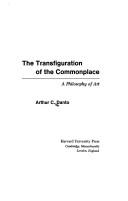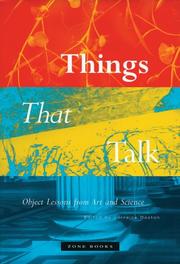| Listing 1 - 3 of 3 |
Sort by
|
Book
ISBN: 2906571229 9782906571228 Year: 1992 Publisher: Paris : Dis voir,
Abstract | Keywords | Export | Availability | Bookmark
 Loading...
Loading...Choose an application
- Reference Manager
- EndNote
- RefWorks (Direct export to RefWorks)
L'objet qui fut traditionnellement représenté dans l'art sous son aspect strictement fonctionnel se présente désormais dans l'art d'aujourd'hui comme une œuvre à part entière. A travers une approche philosophique et historique l'auteur s'est attaché à la compréhension du statut de l'objet dans l'art d'aujourd'hui mettant en évidence une logique de l'objet dans l'histoire de l'art, l'esthétique, l'art contemporain, qui devait aboutir à son inévitable rencontre avec le design. Cet essai apporte sa contribution au débat sur le statut de l'art aujourd'hui et conteste un certain ton désabusé adopté actuellement par de nombreux critiques et historiens d'art. http://www.disvoir.com
Aesthetics, Modern --- Art --- Object (Aesthetics) --- Art objects --- Sculpture, Modern --- Esthétique moderne --- Objet (Esthétique) --- Objets d'art --- Sculpture --- Philosophy --- Philosophie --- Design --- Installation-art --- Objet --- Théorie de l'art --- Philosophy. --- Esthétique moderne --- Objet (Esthétique) --- Aesthetics, Modern - 20th century. --- Art - Philosophy. --- Objet (esthétique). --- Esthétique --- Art et industrie. --- Philosophie.

ISBN: 0674903455 2020104636 9782020104630 Year: 1989 Publisher: Paris : Éditions du Seuil,
Abstract | Keywords | Export | Availability | Bookmark
 Loading...
Loading...Choose an application
- Reference Manager
- EndNote
- RefWorks (Direct export to RefWorks)
Aesthetics --- Art --- -Art, Occidental --- Art, Visual --- Art, Western (Western countries) --- Arts, Fine --- Arts, Visual --- Fine arts --- Iconography --- Occidental art --- Visual arts --- Western art (Western countries) --- Arts --- Beautiful, The --- Beauty --- Esthetics --- Taste (Aesthetics) --- Philosophy --- Criticism --- Literature --- Proportion --- Symmetry --- Psychology --- Aesthetics. --- Philosophy. --- -Philosophy --- -Beautiful, The --- Art, Occidental --- Art and philosophy --- Analysis, interpretation, appreciation --- Non-fiction --- American literature --- Radio broadcasting Aesthetics --- Vulgarité. --- Objets usuels --- Objet (esthétique) --- Philosophie. --- Dans l'art. --- Art objects --- Esthétique --- Objets d'art --- Philosophie

ISBN: 9781890951443 1890951439 1890951447 Year: 2004 Publisher: New York : Zone Books,
Abstract | Keywords | Export | Availability | Bookmark
 Loading...
Loading...Choose an application
- Reference Manager
- EndNote
- RefWorks (Direct export to RefWorks)
Imagine a world without things. There would be nothing to describe, explain, remark on, interpret, or complain about. Without things, we would, in short, stop speaking ; we would become as mute as objects are alleged to be. In nine original essays, internationally renowned historians of art and of science seek to understand how objects become charged with significance without losing their gritty materiality. Things That Talk aims to escape the opposition between positivist facts and cultural readings that bifurcates the current historiography of both art and science. Confronting this impasse from an interdisciplinary perspective, each author singles out one object for close attention : a Bosch drawing, the freestanding column, a Prussian island, soap bubbles, early photographs, glass flowers, Rorschach blots, newspaper clippings, paintings by Jackson Pollock. Each object is revealed to be a node around which meanings accrete thickly. But not just any meanings: what these things are made of and how they are made shape what they can mean. Neither the pure texts of semiotics nor the brute objects of positivism, these things are saturated with cultural significance. Things become talkative when they fuse matter and meaning; they lapse into speechlessness when their matter and meanings no longer mesh.
Art and science. --- Semiotics and art. --- Object (Aesthetics) --- Object (Philosophy) --- 7.01 --- 7.03 --- Pollock Jackson --- Grosz George --- collage --- montage --- krantenknipsels --- rorschachtest --- Rorschach Hermann --- plantkunde --- botanica --- fotografie --- zeepbellen --- Pfaueninsel --- eilanden --- zuilen --- architectuur --- Bosch Hieronymus --- designtheorie --- productdesign --- perceptie --- waarneming --- kunsttheorie --- kunst en wtenschap --- kunst --- Philosophy --- Aesthetic object --- Aesthetics --- Art and semiotics --- Art --- Science and art --- Science --- Art et sciences --- Sémiotique et art --- Objet (Esthétique) --- Objet (Philosophie) --- Object (Aesthetics). --- Sémiotique et art --- Objet (Esthétique) --- Art and science --- Semiotics and art --- Semiotics --- Object (Philosophy). --- Sémiotique --- Objet --- Analyse de l'art --- Culture
| Listing 1 - 3 of 3 |
Sort by
|

 Search
Search Feedback
Feedback About
About Help
Help News
News